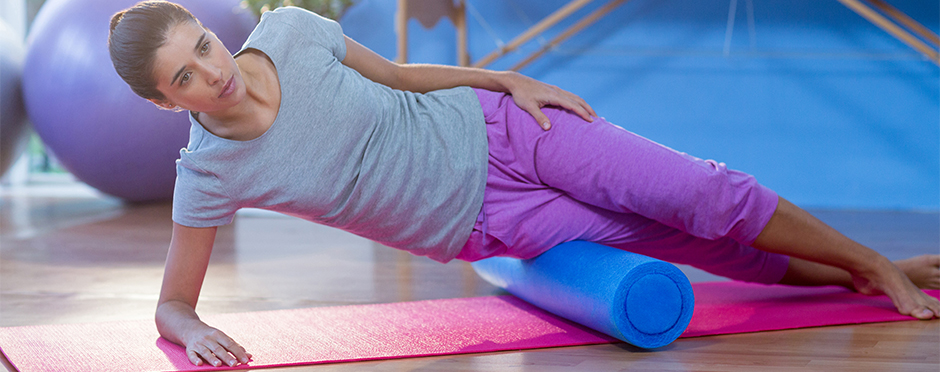
Top Areas to Foam Roll for Gymnasts
Leave a CommentWarm-up and recovery are important parts of a workout routine that often get overlooked. A dynamic warm-up prepares the body prior to exercise; conversely, recovery or cooling down after exercise can help manage soreness. Active recovery is a great option to help manage normal muscle soreness symptoms after high-intensity workouts. It is normal to have muscle soreness after high- intensity exercise; this can last for several hours up to several days. Active recovery may help reduce muscle soreness and fatigue.
Male and female gymnasts should use both warm-up and active recovery techniques at practices, and they can use recovery techniques on the days when they are not training in the gym. There are several warm-ups and active recovery methods; one example of a warm-up activity and an active recovery technique is foam rolling.
Benefits of Foam Rolling
Foam rolling is often done either before or after a workout, or both. When performing foam rolling, the person directly exerts pressure on the foam roller; we say this is “active” as the person is involved in administrating the technique. This contrasts with manual massage, where the person is usually passive while another individual exerts pressure on the muscles.
There is an emerging consensus that foam rolling has short-term positive effects on athletic performances such as power, strength, agility, balance, and flexibility2, which is why foam rolling before exercise can be beneficial. Other short-term effects of foam rolling were immediate gains in flexibility and range of motion. It can also substantially reduce perceived muscle pain after exercise2, 3, which can be beneficial. Long-term results of foam rolling are less consistent and less clear, but foam rolling did not appear to have any negative effects on athletic performance2.
Areas Gymnasts Should Foam Roll
Both male and female gymnasts train multiple days each week, year-round. Certain areas get overused during tumbling, weight-bearing on the arms, and hanging activities such as those required in gymnastics. Here are some top areas gymnasts should focus on when performing foam rolling:
1. Glutes
Begin by sitting on the foam roller with your hands on the floor behind you. Cross your ankle over your opposite knee and tilt toward the bent leg side. The foam roller will be over the “back pocket” area on one side; roll here in a small forward and backward motion. Make sure to perform on both sides. Perform for 2-3 minutes per side.
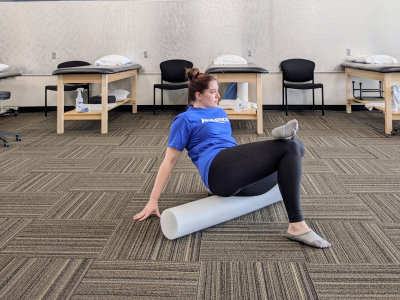
2. Iliotibial Band (ITB)/ Tensor Fascia Latae (TFL)
Place your hip right on top of the foam roller and come down onto your elbow. The Tensor Fascia Latae or TFL is just underneath your hip bone. Roll along the side of your leg until just above your knee. Do not roll directly on the knee or hip joint. You can cross your other leg over the top and use your foot on the ground to help give you more control. The ITB area can get tender or uncomfortable during foam rolling, so use your hands to help control the pressure over these areas. Roll along the entire side of the leg for 2-3 minutes per side. If you find a spot that feels tighter, you can focus on that area for 30-60 more seconds. Perform on both sides.
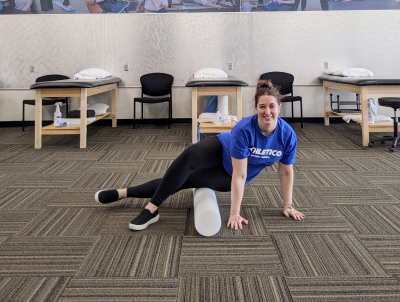
3. Quads
Begin by lying on top of the foam roller on your elbows. You can foam roll both legs simultaneously, or you can focus on individual legs. Roll up and down the length of your thighs, do not go directly over the hip or knee. Like the ITB, if you find an area that feels tighter, you can stay and focus on that area for longer. Foam roll your quads for 2-3 minutes total.
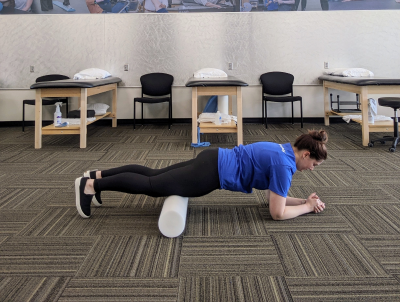
4. Latissimus Dorsi
Begin by lying on your side on your foam roller with the arm extended overhead. You want the foam roller to be where your back and shoulder meet; keep your thumb pointing up. Use your other arm to stabilize yourself on the ground. Keep your core engaged and roll slowly down your side toward your hip but do not roll on your rib cage. Repeat slowly for 2-3 minutes on each side. Make sure to keep breathing during this activity.
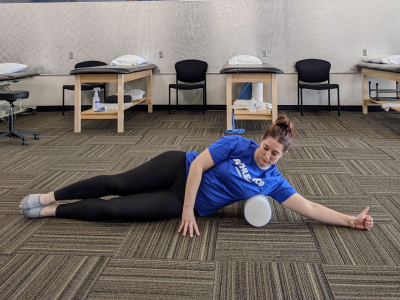
5. Calves
Begin sitting on the ground with your legs in front of you with the calves resting on the foam roller. Using your arms to help, roll along the calf muscles apply as much pressure as you can tolerate. You can also point or flex your foot to work into an area more. Perform for 2-3 minutes total.
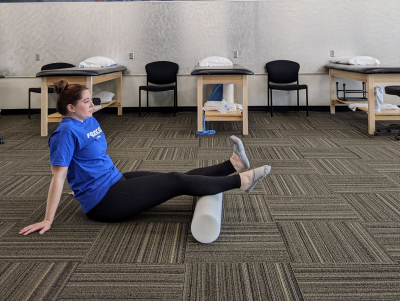
6. Thoracic Spine Extension
Start with the foam roller on the middle of your back, and work your way up towards your upper back, performing a few extensions every few inches as you move up. You can have your arms crossed over your chest or behind your head. Avoid arching in your low back by keeping your bottom on the ground.
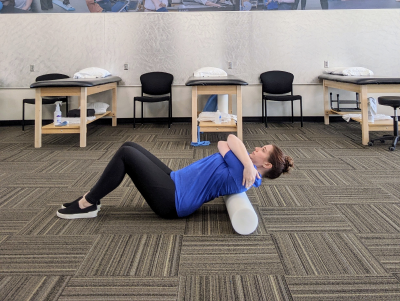
Try these foam rolling suggestions the next time you are feeling sore before or after practice and see if they help you recover better.
Find your closest Athletico location with a gymnastics specialist if you have more questions.
*Per federal guidelines, beneficiaries of plans such as Medicare, Medicaid, Tricare, VHA and other federally funded plans are not eligible for free assessments.
The Athletico blog is an educational resource written by Athletico employees. Athletico bloggers are licensed professionals who abide by the code of ethics outlined by their respective professional associations. The content published in this blog is for informational purposes only, does not constitute medical advice and should not be relied on for making personal health decisions.
References:
1. Wiewelhove T, Döweling A, Schneider C, Hottenrott L, Meyer T, Kellmann M, Pfeiffer M, Ferrauti A. A Meta-Analysis of the Effects of Foam Rolling on Performance and Recovery. Front Physiol. 2019 Apr 9;10:376. doi: 10.3389/fphys.2019.00376. PMID: 31024339; PMCID: PMC6465761.
2. Kerautret Y, Di Rienzo F, Eyssautier C, Guillot A. Selective Effects of Manual Massage and Foam Rolling on Perceived Recovery and Performance: Current Knowledge and Future Directions Toward Robotic Massages. Front Physiol. 2020;11:598898. Published 2020 Dec 21. doi:10.3389/fphys.2020.598898
3. Pearcey GE, Bradbury-Squires DJ, Kawamoto JE, Drinkwater EJ, Behm DG, Button DC. Foam rolling for delayed-onset muscle soreness and recovery of dynamic performance measures. J Athl Train. 2015 Jan;50(1):5-13. doi: 10.4085/1062-6050-50.1.01. Epub 2014 Nov 21. PMID: 25415413; PMCID: PMC4299735.
